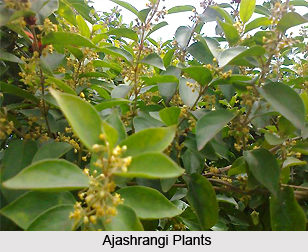 Ajashrangi is found in dry forests in the hilly areas of Bihar, Orissa and Madhya Pradesh. This plant is also found in southern India at an elevation of 650 metres. In Central India, it is abundantly found on soils derived from sandstone. The botanical name of Ajashrangi is Gymnema sylvestre (Retz.). It has several common names which vary according the different Indian province. This Indian medicinal plant is known as Gadalshingi, Merasingi and Meshasingi in Bengali, Australian Cow Plant and Periploca of The Woods in English, Chhotadudhilata, Gur-mar, and Merasingi in Hindi, Dhuleti and Mardashingi in Gujarati, Ajashrangi, Ajashringi, Meshashrangi and Meshashringi in Sanskrit and Kakarsingi, Kakrasingi and Mendhasingi in Urdu.
Ajashrangi is found in dry forests in the hilly areas of Bihar, Orissa and Madhya Pradesh. This plant is also found in southern India at an elevation of 650 metres. In Central India, it is abundantly found on soils derived from sandstone. The botanical name of Ajashrangi is Gymnema sylvestre (Retz.). It has several common names which vary according the different Indian province. This Indian medicinal plant is known as Gadalshingi, Merasingi and Meshasingi in Bengali, Australian Cow Plant and Periploca of The Woods in English, Chhotadudhilata, Gur-mar, and Merasingi in Hindi, Dhuleti and Mardashingi in Gujarati, Ajashrangi, Ajashringi, Meshashrangi and Meshashringi in Sanskrit and Kakarsingi, Kakrasingi and Mendhasingi in Urdu.
Generally Ajashrangi plants are large, stout and woody climbers with dense hairy branches. These climbers frequently cover the tops of trees. The leaves of this Ajashrangi plant are oppositely placed and are elliptic in shape. Usually these leaves are 2 to 6 cms long with a rounded base. The flowers of this plant are 4-5 mm in length and are yellow in colour. The fruits or follicles are slender, cylindrical and glabrous. These are 6.3 to 7.6 cms long and 0.8 cm wide; and bear pale brown ovoid seeds in it.
Ajashrangi plants are cultivated as a medicinal plant in India. It is important for its antiperiodic, diuretic and stomachic values. In Ayurveda, the root and the leaf are used to treat headache, polyuria, leprosy, pruritus, poisoning, wounds, bronchial asthma and several other diseases. The leaves are believed to be hypoglycaemic and are an important ingredient of Ayurvedic medicines treating diabetes. Ajashrangi plants are also helpful in curing cough and fever.
In some regions of India the leaves of Ajashrangi plants are mixed with a small portion of the seed kernel of Syzygium cumini (Myrtaceae). This mixture is taken internally with water on an empty stomach to regularize the menstrual cycle. Similarly, in some other parts of India the leaf paste is used externally to promote the healing of bone fractures. The leaves of this plant are also used as an external application to relieve swollen glands and enlarged spleen. The leaf powder stimulates the heart and circulatory system and increases urine production. It is also used for the diseases like parageusia, furunculosis and as an errhine. In Andhra Pradesh, Gond community people use the filtered extract of the ground leaf twigs of Ajashrangi plant is taken orally to relieve malarial fever. The seeds are also used as medicines for several diseases. They are used to cure colds. The root of this medicinal plant is considered to possess astringent, emetic, expectorant, cooling, stomachic and tonic properties.



















